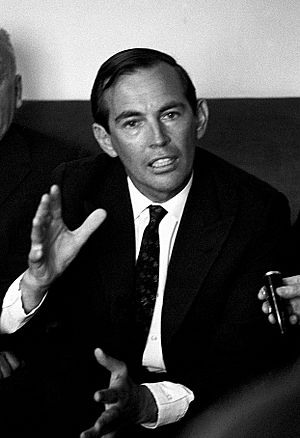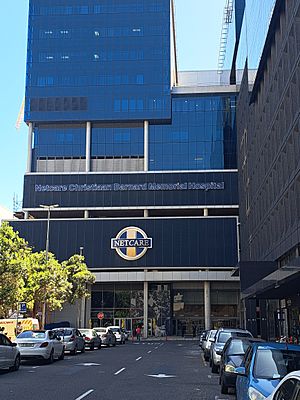Christiaan Barnard facts for kids
Quick facts for kids
Christiaan Barnard
|
|
|---|---|

Barnard in 1969
|
|
| Born |
Christiaan Neethling Barnard
8 November 1922 Beaufort West, Cape Province, Union of South Africa
|
| Died | 2 September 2001 (aged 78) Paphos, Cyprus
|
| Education |
|
| Years active | 1950–2001 |
| Known for | First successful human-to-human heart transplant |
| Relatives | Marius Barnard (brother) |
| Medical career | |
| Profession | Surgeon |
| Institutions |
|
| Sub-specialties |
|
Christiaan Neethling Barnard (born November 8, 1922 – died September 2, 2001) was a famous South African heart surgeon. He made history by performing the world's first successful human-to-human heart transplant. This amazing operation happened on December 3, 1967.
Barnard transplanted the heart of Denise Darvall, an accident victim, into Louis Washkansky, who was 54 years old. Washkansky woke up and could talk after the surgery. He lived for 18 days before passing away from pneumonia. This was mainly caused by medicines that stopped his body from rejecting the new heart. Barnard's second patient, Philip Blaiberg, lived for a year and a half after his transplant in 1968.
Barnard was born in Beaufort West, South Africa. He studied medicine and became a doctor in his home country. Early in his career, he found a way to fix a birth defect in babies' intestines. This new method saved the lives of many babies. In 1955, he went to the United States to learn more about surgery. There, he became very interested in heart surgery and learned from top doctors. When he returned to South Africa in 1958, he became the head of experimental surgery at Groote Schuur Hospital.
He stopped performing surgeries in 1983 because of arthritis in his hands. He then focused on helping children around the world through the Christiaan Barnard Foundation. He died in 2001 at age 78 from an asthma attack.
Contents
Early Life and Education
Christiaan Barnard grew up in Beaufort West, South Africa. His father, Adam Barnard, was a minister. Christiaan had four brothers. One of his brothers, Abraham, died young from a heart problem. This sad event may have inspired Christiaan to become a heart surgeon.
His mother, Maria Elisabeth de Swart, taught her children to believe they could achieve anything. Christiaan finished high school in 1940. He then went to the University of Cape Town to study medicine. He earned his medical degree in 1945.
Becoming a Surgeon
Barnard started his medical career at Groote Schuur Hospital in Cape Town. After that, he worked as a general doctor in a small town called Ceres. In 1951, he returned to Cape Town and continued his training. He earned a master's degree in medicine in 1953. He also received a doctorate for his work on treating a type of brain infection.
Fixing Intestinal Problems
Early on, Barnard did research on dogs. He was trying to understand a birth defect where babies' intestines were blocked. He discovered that this problem was caused by not enough blood flow to the baby's intestines before birth. He found a way to fix this by removing the unhealthy part of the intestine.
This new method saved the lives of ten babies in Cape Town. Doctors in Britain and the United States also started using his technique.
Learning in the United States
In 1955, Barnard traveled to the University of Minnesota in the United States. He first worked on intestine research. But he soon became fascinated by open-heart surgery. He learned from pioneering surgeons like Walt Lillehei. During this time, he also met Norman Shumway, another future heart transplant surgeon.
Barnard spent two years in the U.S., which he called "the most fascinating time in my life." He earned more degrees for his work on heart valves and intestinal problems.
Return to South Africa
When Barnard came back to South Africa in 1958, he became the head of experimental surgery at Groote Schuur Hospital. He also taught at the University of Cape Town. In 1960, he visited Vladimir Demikhov in Moscow, a leading expert on organ transplants. Barnard later said Demikhov was like the "father of heart and lung transplantation."
In 1961, Barnard became the head of heart and chest surgery at the University of Cape Town's hospitals. His younger brother, Marius, also a doctor, became his main assistant. Barnard became known for his skill in treating various heart diseases. He became a full professor in 1972.
The First Human Heart Transplant
Before Barnard's famous surgery, doctors had already done kidney transplants. In 1964, a surgeon named James Hardy tried to transplant a chimpanzee heart into a human. The heart beat for a short time, but the patient did not survive.
Barnard had practiced heart transplants on many dogs. Other surgeons, like Adrian Kantrowitz and Norman Shumway, had done even more. But Barnard had a patient who was ready for the procedure. He just needed a suitable donor.
Hamilton Naki's Contribution
During the time of Apartheid in South Africa, people of different races were treated unfairly. At Groote Schuur Hospital, a man named Hamilton Naki was a skilled surgeon, even though he was not formally trained. He started as a gardener and cleaner. He became a main lab technician and taught many surgeons. He also helped Barnard with his organ transplant program. Barnard himself said that Hamilton Naki had better surgical skills than he did, especially with stitching.
The Historic Operation
The world's first human-to-human heart transplant happened early on Sunday, December 3, 1967. Louis Washkansky, a 54-year-old grocer with severe heart disease, was the patient. Barnard was helped by his brother Marius and a team of 30 medical staff. The surgery took about five hours.
Barnard told Washkansky and his wife that the operation had an 80% chance of success. The donor heart came from Denise Darvall, a young woman who had a serious accident. Doctors determined she had no brain activity. Her father gave permission for her heart to be used.
Before the transplant, Barnard made a change to the usual technique to protect the donor heart better. To stop Darvall's heart from beating, Barnard injected potassium into it. This made her technically dead by the whole-body standard.
Washkansky lived for 18 days after the operation. He died from pneumonia, likely because of the medicines that weakened his immune system. These medicines were needed to stop his body from rejecting the new heart.
Life After the First Transplant
Barnard and his patient became famous worldwide. News reporters and film crews came to Cape Town. Barnard was seen as a charming and photogenic doctor. Even though Washkansky lived only 18 days, the operation was first called a "success."
In 1968, about 100 heart transplants were done by different doctors around the world. But only a third of these patients lived longer than three months. Many hospitals stopped doing transplants because of the poor results.
Barnard's second transplant patient, Philip Blaiberg, had his surgery on January 2, 1968. He lived for 19 months. Blaiberg's heart came from Clive Haupt, a 24-year-old black man. This caused some discussion because of South Africa's apartheid laws at the time. Dirk van Zyl, who received a new heart in 1971, lived for over 23 years, making him one of the longest-living recipients.
Between 1967 and 1974, Groote Schuur Hospital performed ten heart transplants. Four of these patients lived longer than 18 months. One patient, Dorothy Fischer, lived for over 13 years, and another for over 24 years.
The "Piggyback" Transplant
Sometimes, a patient's own heart is too damaged to be removed completely. Barnard came up with the idea of a "piggyback" transplant, also called a heterotopic transplant. In this surgery, the patient's diseased heart is left in place, and the donor heart is added, creating a "double heart."
Barnard performed the first piggyback heart transplant in 1974. This method improved survival rates. For these patients, over 60% lived for one year, and over 36% lived for five years. This was much better than standard transplants at the time.
Many surgeons stopped doing heart transplants because patients' bodies often rejected the new heart. Barnard kept going until a new medicine called cyclosporine became available. This drug helped prevent rejection and made heart transplants more successful around the world.
Public Life and Views
Christiaan Barnard spoke out against South Africa's apartheid laws. These laws treated people of different races unfairly. He used his fame to push for changes in the law. His brother, Marius Barnard, even became a politician and worked for change. Barnard believed he did not win the Nobel Prize because he was a "white South African" during that time.
Barnard believed in allowing African people to participate in South African politics. However, he did not support a "one-person, one-vote" system for the whole country. He thought the country might need to be divided by race. He believed mixed-race people should be included with white South Africans.
Personal Life
Barnard was married three times and had six children. His first wife was Aletta Gertruida Louw, a nurse. They married in 1948 and had two children, Deirdre and Andre. They divorced in 1969.
In 1970, he married Barbara Zoellner. They had two sons, Frederick and Christiaan Jr. They divorced in 1982. His third marriage was to Karin Setzkorn, a model, in 1988. They had two children, Armin and Lara. This marriage ended in 2000.
Retirement and Later Years
Barnard stopped being the head of heart and chest surgery in Cape Town in 1983. He had developed rheumatoid arthritis in his hands, which made it impossible for him to perform surgery. He had been dealing with arthritis since 1956.
After retiring, he spent time in the United States as a scientist. He also became interested in research about anti-aging. In 1986, he promoted an expensive "anti-aging" skin cream called Glycel. The United States Food and Drug Administration later removed its approval for this cream.
Barnard spent his later years between Austria and his farm in South Africa. In Austria, he started the Christiaan Barnard Foundation. This foundation helps children in need around the world. He also had skin cancer on his face, which was treated in South Africa.
Death
Christiaan Barnard died on September 2, 2001, while on vacation in Cyprus. At first, people thought he died of a heart attack. However, an examination showed that he died from a severe asthma attack.
Books
Barnard wrote two autobiographies, which are books about his own life. His first book, One Life, came out in 1969 and sold many copies. Some of the money from the book helped fund research into heart disease. His second autobiography, The Second Life, was published in 1993.
He also wrote other books, including:
- The Donor
- Your Healthy Heart
- In The Night Season
- The Best Medicine
- Arthritis Handbook: How to Live With Arthritis
- South Africa: Sharp Dissection
- 50 Ways to a Healthy Heart
- Body Machine
See also
 In Spanish: Christiaan Barnard para niños
In Spanish: Christiaan Barnard para niños
- Bartley P. Griffith
- René Favaloro
- Pierre Grondin
- Hamilton Naki
- Geoffrey Tovey



